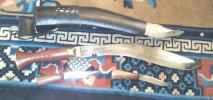I have two scabbards with the new village sarki construction. Some observations-
One (AK) has noticably heavier leather with a more defined grain covering the wood. Preferable to me, but tooling would be a lovely addition if it doesn't mean thinner leather.
AK scabard had a frog that had a 1/4" gap between the laced edges and I think you'd have to cut the laces or soak it to remove it. I wonder if it was shrunk on. The other (GS) had a frog that was a little large--with laced edges touching, still kinda loose. I only had a smaller piece of leather, about the width of the belt loop which I used as a shim inserted between the belt loop and the scabbard. this works, but I'm not gluing it into the frog yet (no real need to anyway). This fix, and especially simply pushing the frog up higher until it catches tend to compress the tool compartment too much. Maybe fitting a strap inside the frog under the front and sides so it is all a double thickness will work better .
The patches over the tack heads are a good idea. The GS scabbard has them. The glue used seems to be a kinda rubbery contact cement (?) so you may want to reglue them as I did. If you want to add these patches to loops without them, keep in mind the frog squeezing the tool compartment. Staples instead of tacks might be easier to pound down enough to get things recessed below the leather surface.
I found both scabbards fairly loose regarding the main blade. Instead of gluing a shim over the leather in the back of the throat as suggested by Yvsa, I lifted out the front flap of leather with a piece of coat-hanger I'd given a screw-driver-like bit and bent into a hook. The back side has peened-over tack points. I glued a tapered leather shim to the wood, and after checking for fit then folded the leather back in and glued it down in small sections starting from the narrow edge side. Yvsa's method is easier, and if the peened over tack points on that side are high, probably the way to go. I think mine may look a little cleaner, and the Yvsa method is still an option. The GS scabbard had the "contact cement" under the front flap.
If glue is to be used by the Sarkis I actually prefer the contact cement. It's easy to rework things if you want, or just reglue if you don't change anything. I would hate to see any reliance on glue in the scabbard construction. The tension of the free-floating shrunken leather over the wood is a resilient self-adapting system that tends to keep pulling everything into the proper configuration. It's a little bit alive, kinda like a wooden boat is compared to a glass boat.
Things I've learned:
Position of frog and presence or absence of small tools affect tightness. Remember this when checking for fit before gluing-up.
Be careful how far back to the edge side the shim extends to prevent slicing the leather later. This is the hardest place to get the leather tucked back as well--don't make it any harder. A small piece of the flap will probably need to be trimmed to fit properly over the now smaller area. Trim slowly--gone means gone!
Unless the leather flap tucks in really well, you will have to check the glued-in shim for fit without tucking the flap back in to avoid cutting it, not really a problem, the leather will compress a little anyway, or you can thin the shim with an X-acto knife if its too tight.
Glue the flap down in sections starting from the edge side. A butter knife works great for pushing the leather around and holding things flat while slow-dry super-glue sets up. The last section to be glued down will probably need a slight trim to lay flat--things probably got stretched during gluing.
Removing small tools (pretty obvious!) and making sure frog isn't squeezing things will loosen things up while working.
Conversly, if you are doing any prying, or pushing hard to flatten things while glueing, be careful about spreading things out too much at the seams in the wood especially the spine side. The edge side is likely what your'e trying to open up anyway. You may want to hold the spine side tightly, or put a tool in the spine side loop and bind or clamp the top of the scabbard. On this point, thicker leather is a real plus, even if it is harder to tuck back in.
Maybe a small wedge between the tool loops would open the tool compartment, allow the frog to be tighter, and tighten the fit on the main blade all at once?? Hmmmm....
Overall, I find these two scabbards, to be of fine quality, and great design. It's just that some things like these scabbards and knives, compel me to fiddle with them to try to make them completely perfect. Kinda schizophrenic, because I'm generally not too tidy, and consider many objects to be just fine as long as they work. Maybe the difference is soul vs no soul in the object.
Rambling discourse over.

